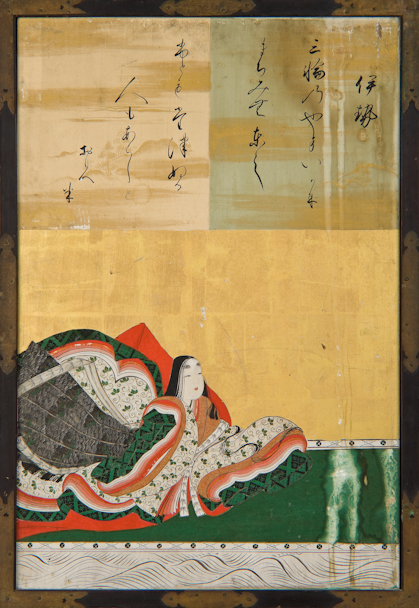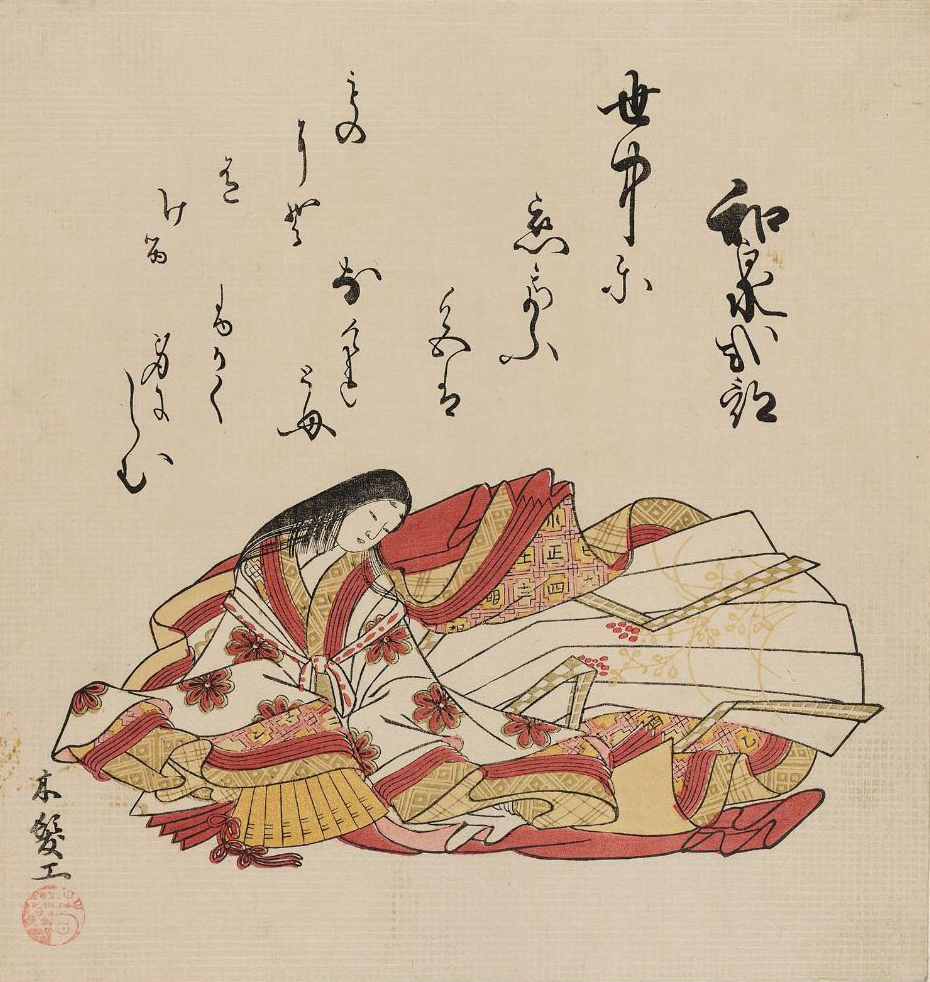|
Thirty-Six Immortal Women Poets
The Thirty-Six Immortal Women Poets (女房三十六歌仙 ''Nyōbō Sanjūrokkasen''), is a canon of Japanese poets who were anthologized in the middle Kamakura Period. The compiler and exact date of the canon's construction is unknown, but it's reference is subsequently noted in the Gunsho Ruijū, volume 13. Five of the 36, Ono no Komachi, Lady Ise, Nakatsukasa, Saigū no Nyōgo and Kodai no Kimi also appeared in an earlier anthology with the similar title ''Thirty-Six Immortals of Poetry'' which dates from 1113 (late Heian Period). The poet Fujiwara no Kintō chose this original selection that preceded the ''Thirty-Six Immortal Women Poets''. These five women poets from the original publication were included in the ''Thirty-Six Immortal Women Poets'' and canonized along with others from the Heian and Kamakura eras. Role of women's court poetry in Heian-era Japan The women canonized in this compilation are typically noblewomen associated with the imperial court, for exam ... [...More Info...] [...Related Items...] OR: [Wikipedia] [Google] [Baidu] |
Michitsuna No Haha
Fujiwara no Michitsuna no Haha (藤原道綱母, 935–995) was a waka poet in the Mid Heian period. She was in her mid-thirties when she began to write her journal ''Kagerō Nikki,'' written in a combination of waka poems and prose. Her diary gave access to a woman's experience of a thousand years ago, with poems she recorded which vividly recall the past. These poems conveyed the life of a noblewoman during the Heian Period. She is one of the ''Nihon Sandai Bijin'' (The Three Beauties of Japan). Her true name is unknown to history. Name While her true name is unknown to history, she is known by the name "Fujiwara no Michitsuna no Haha," that translates to "Fujiwara clan's Michitsuna's Mother". Life She was the daughter of a provincial governor, Fujiwara no Tomoyasu, a member of the middle-ranking aristocracy of the Heian period (794–1185) from which were drawn men who served as provincial governors. Due to her lesser nobility, she became a concubine at the age of ninet ... [...More Info...] [...Related Items...] OR: [Wikipedia] [Google] [Baidu] |
Ise No Taifu
, also known as Ise no Tayū or Ise no Ōsuke, was a Japanese poet active in the early 11th century. She is one of the later Thirty-six Poetry Immortals, and one of her poems is included in the ''Ogura Hyakunin Isshu''. Her contemporaries include Uma no Naishi, Murasaki Shikibu, and Sei Shōnagon. A diptych of her exists i''Nihon Meijo Banashi'' (Stories of Famous Japanese Women) implying that although little of her work exists into modernity, she was considered a critically important figurehead of the ''waka'' poetry movement, both as a Poetry Immortal and as a woman of renown. Her grandfather Ōnakatomi no Yoshinobu Ōnakatomi no Yoshinobu (921–991, 大中臣 能宣, also Ōnakatomi no Yoshinobu Ason 大中臣能宣朝臣) was a middle Heian period '' waka poet'' and Japanese nobleman. His granddaughter was the famous later Heian poet Ise no Taiu. He is d ... was also an important ''waka'' poet. Her mother, Kura no Myobu, served Fujiwara no Yorimichi, the first son of ... [...More Info...] [...Related Items...] OR: [Wikipedia] [Google] [Baidu] |
Gofukakusa-in No Shōshō No Naishi
Gofukakusa-in no shōshō no naishi ( died: around 1265), (also Shōshō no Naishi) was a Japanese poet during the Kamakura period. She was among the Thirty-Six Immortals of Poetry. She was the daughter of the artist and aristocrat Fujiwara no Nobuzane and the younger sister of the poets Ben no naishi, Sōhekimon-in no shōshō and the painter Fujwara no Tametsugu. She served as the court lady of Emperor Go-Fukakusa, from where her nickname comes. Together with her sister Ben no naishi, she belonged to a group of Renga-style poets whose works were included in the Tsukubashū collection created around 1356 Year 1356 ( MCCCLVI) was a leap year starting on Friday (link will display the full calendar) of the Julian calendar. Events January–December * January 20 – Edward Balliol surrenders his title as King of Scotland, to Edward II .... References 1265 deaths Year of birth unknown Japanese poets Japanese women poets {{Japan-poet-stub Kamakura p ... [...More Info...] [...Related Items...] OR: [Wikipedia] [Google] [Baidu] |
Koshikibu No Naishi
was a Japanese ''waka'' poet of the early eleventh century.''Britannica Kokusai Dai-hyakkajiten'' article "Koshikibu no Naishi". 2007. Britannica Japan Co.'' Mypaedia'' article "Koshikibu no Naishi". 2007. Hitachi Systems & Services.''Digital Daijisen'' entry "Koshikibu no Naishi". Shogakukan. One of her poems was included in the ''Ogura Hyakunin Isshu''.McMillan 2010 : 142 (note 60).Suzuki et al. 2009 : XX. Biography She was the daughter of Izumi Shikibu and , the governor of Mutsu. Starting around 1009, she joined her mother in serving Empress Shōshi. A target of many suitors, she eventually married . She bore him a child, but died thereafter, still in her late twenties. Poetry Four of her poems were included in imperial anthologies such as the ''Goshūi Wakashū'' and the ''Kin'yō Wakashū''. ''Ōe-yama'' The following poem by her was included as No. 60 in Fujiwara no Teika's ''Ogura Hyakunin Isshu'': In later literature Numerous anecdotes about her were incorpo ... [...More Info...] [...Related Items...] OR: [Wikipedia] [Google] [Baidu] |
Ben No Naishi
Ben no Naishi (1220s?–ca. 1270?) was a 13th-century Japanese court lady, poet and memoirist. Ben no Naishi was the daughter of the poet and painter Fujiwara Nobuzane; her younger sister Shosho no Naishi was also a poet. She served at court as a lady in waiting to Emperor Go-Fukakusa from 1243 until the Emperor's abdication in 1259. During her time as a lady in waiting she was responsible for the three Imperial Regalia of Japan, imperial regalia of Japan. Her memoir, ''Ben no naisha nikki'', begins with Go-Fukakusa's accession aged three in 1246, and ends (the text is damaged) in 1252. References Year of birth unknown Year of death unknown 13th-century births 13th-century deaths Japanese diarists Women memoirists 13th-century Japanese women writers Japanese women poets {{Japan-poet-stub ... [...More Info...] [...Related Items...] OR: [Wikipedia] [Google] [Baidu] |
Murasaki Shikibu
was a Japanese novelist, poet and lady-in-waiting at the Imperial court in the Heian period. She is best known as the author of '' The Tale of Genji,'' widely considered to be one of the world's first novels, written in Japanese between about 1000 and 1012. Murasaki Shikibu is a descriptive name; her personal name is unknown, but she may have been , who was mentioned in a 1007 court diary as an imperial lady-in-waiting. Heian women were traditionally excluded from learning Chinese, the written language of government, but Murasaki, raised in her erudite father's household, showed a precocious aptitude for the Chinese classics and managed to acquire fluency. She married in her mid-to late twenties and gave birth to a daughter before her husband died, two years after they were married. It is uncertain when she began to write ''The Tale of Genji'', but it was probably while she was married or shortly after she was widowed. In about 1005, she was invited to serve as a lady-in-wait ... [...More Info...] [...Related Items...] OR: [Wikipedia] [Google] [Baidu] |
Go-Toba-in No Shimotsuke
was a '' waka'' poet and Japanese noblewoman active in the Kamakura period. Many of her poems appear in imperial poetry collections, including ''Shingoshūi Wakashū'', '' Senzai Wakashū'', ''Shokugosen Wakashū'', ''Gyokuyō Wakashū'', ''Shinsenzai Wakashū The , sometimes abbreviated as Shinsenzaishū, a title which recollects the ''Senzai Wakashū'', is an imperial anthology of Japanese waka. The title is in opposition to the prior Senzai Wakashū. It was completed in 1359, three years after being c ...'', '' Shinchokusen Wakashū'', and others. She is designated as a member of the . She is also known as . External links E-text of her poemsin Japanese Japanese poets Japanese women poets People of Kamakura-period Japan {{japan-writer-stub ... [...More Info...] [...Related Items...] OR: [Wikipedia] [Google] [Baidu] |
Kojijū
Kojijū (小侍従; 1121–1202) was a ''waka'' poet and Japanese noblewoman active in the late Heian period. She is designated a member of the . She left a private collection of poems titled the ''Kojijū-shū The ''Kojijū-shū'' (小侍従集) is a Japanese anthology of ''waka'' poetry. It is the personal anthology ('' kashū'') of Kojijū. Compiler and date The earliest form of the ''Kojijū-shū'', the personal anthology of the twelfth-century ' ...''. In 1179, she became a Buddhist nun. References Works cited * External links E-text of her poemsin Japanese 1121 births 1202 deaths People of Heian-period Japan Heian period Buddhist nuns 12th-century Japanese poets Japanese women poets {{japan-writer-stub ... [...More Info...] [...Related Items...] OR: [Wikipedia] [Google] [Baidu] |
Izumi Shikibu
was a mid-Heian period Japanese poet. She is a member of the . She was the contemporary of Murasaki Shikibu, and Akazome Emon at the court of empress Joto Mon'in. She "is considered by many to have been the greatest woman poet of the Heian period". Her legacy includes 242 poems and two '' kashu''. "Torn between worldly ties and physical desire, Izumi Shikibu left a wealth of passionate love poetry, fueling rumors that purported that she was a femme fatale with numerous lovers besides her two husbands and two princely lovers." Early life Izumi Shikibu was the daughter of Oe no Masamune, governor of Echizen. Her mother was the daughter of Taira no Yasuhira, governor of Etchu. In 995, at the age of 20, Izumi was married to Tachibana no Michisada, governor of Izumi, the origin for her name. Their daughter was born in 997, Koshikibu no Naishi, who also became a poet. However, Izumi soon divorced, and her former husband died soon afterwards. Introduction by Amy Lowell. As is ... [...More Info...] [...Related Items...] OR: [Wikipedia] [Google] [Baidu] |
Nijōin No Sanuki
was a Japanese ''waka'' poet and noblewoman active in the late- Heian and early-Kamakura period. She was a contributor to the ''Senzai Wakashū'' anthology. A member of the Minamoto clan, she was also known as . Poetry One of her poems is included in the ''Ogura Hyakunin Isshu is a classical Japanese anthology of one hundred Japanese ''waka'' by one hundred poets. ''Hyakunin isshu'' can be translated to "one hundred people, one poem ach; it can also refer to the card game of ''uta-garuta'', which uses a deck compos ...'': External links E-text of her poems(in Japanese) 1140s births 1217 deaths Minamoto clan 12th-century Japanese poets Japanese women poets Hyakunin Isshu poets {{japan-writer-stub ... [...More Info...] [...Related Items...] OR: [Wikipedia] [Google] [Baidu] |
Akazome Emon
was a Japanese ''waka'' poet and early historian who lived in the mid-Heian period. She is a member both of the and the . Biography Akazome Emon's year of birth is unknown, but she was likely born between Tentoku 1 (957) and Kōhō 1 (964). She was officially the daughter of Akazome Tokimochi (赤染時用), but the late-Heian karonsho (book of poetic criticism) ' records that her biological father was her mother's first husband, Taira no Kanemori. A poetic exchange between Emon and Fujiwara no Michitaka, dating to around Ten'en 2 (974) to Jōgen 2 (977), when she was likely in her late teens, is the earliest dateable event in her life. At roughly this time, she went to serve in the household of Minamoto no Masanobu, and for a long time thereafter she served his daughter Rinshi ( ja), the wife of Fujiwara no Michinaga. It was also around this time (Ten'en–Jōgen) that she married , a Confucian scholar and poet of both ''waka'' and '' kanshi''. They had a son, , a daugh ... [...More Info...] [...Related Items...] OR: [Wikipedia] [Google] [Baidu] |





